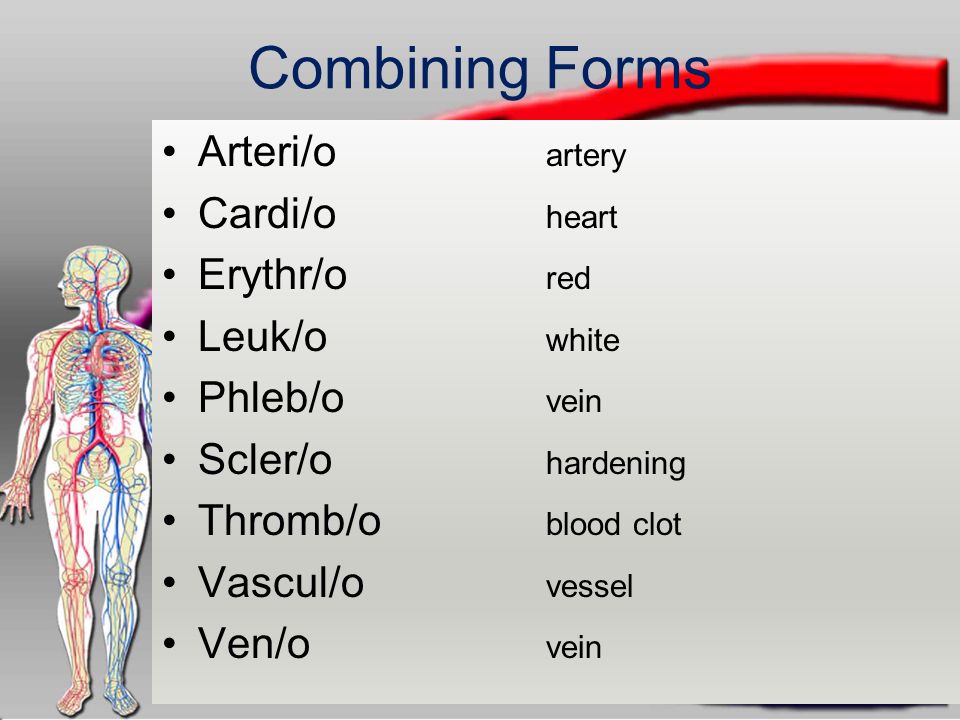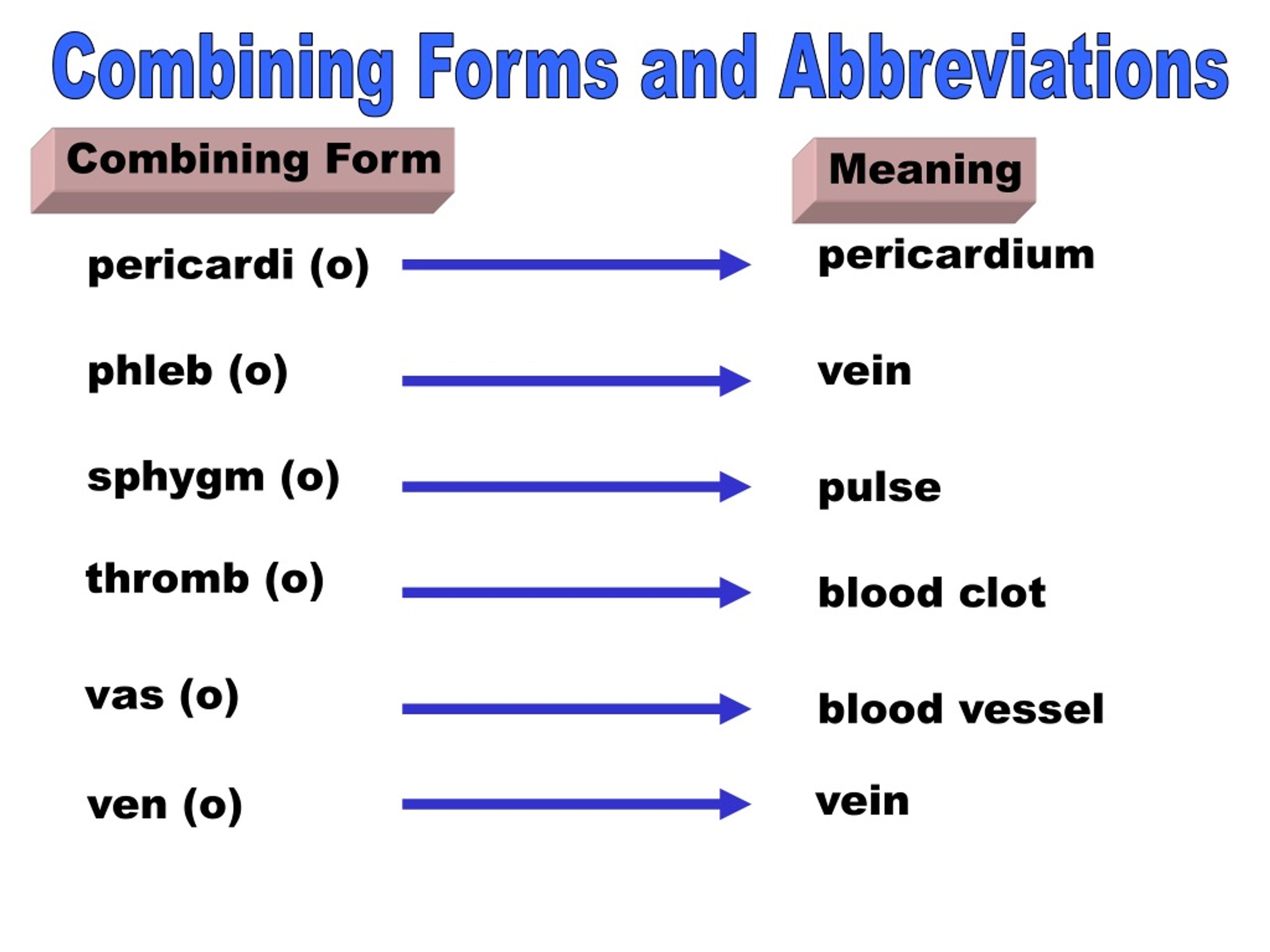Which Is The Combining Form For Blood Vessel

Imagine a vast, intricate network pulsating beneath your skin, a silent river system carrying life's essence to every corner of your being. This hidden world, the circulatory system, relies on a complex array of vessels, each playing a crucial role in maintaining our health. Today, we're diving into the language of medicine to understand how doctors and scientists refer to these vital conduits using specific combining forms.
The primary combining form for blood vessel is indeed angio-. It's a fundamental prefix you'll encounter in many medical terms related to vascular anatomy and physiology. Understanding this root unlocks a wealth of knowledge in the realm of medicine.
But the story of angio- goes deeper than a simple definition. Its origins are rooted in the ancient world, reflecting a long-standing fascination with the body's inner workings.
The Etymology of Angio-
The combining form angio- finds its roots in the Greek word angeion, meaning "vessel". The Greeks, renowned for their contributions to philosophy and medicine, laid the foundation for many anatomical terms we use today.
Over centuries, angeion transitioned into the Latin language and eventually integrated into modern medical terminology. Its core meaning has remained remarkably consistent, always referring to some type of vessel or container.
Angio- in Medical Terminology
The prefix angio- is incredibly versatile. It's used to construct a vast array of medical terms that describe conditions, procedures, and anatomical structures related to blood vessels.
Let's explore some common examples to illustrate its application.
Angiography, for instance, is a diagnostic imaging technique used to visualize blood vessels. It often involves injecting a contrast dye and using X-rays or other imaging modalities to create a detailed map of the vasculature.
Angioplasty, on the other hand, is a minimally invasive procedure used to widen narrowed or blocked blood vessels. It's often performed in cases of atherosclerosis, where plaque buildup restricts blood flow.
Angiosarcoma refers to a rare and aggressive cancer that originates in the lining of blood vessels or lymphatic vessels. It highlights the prefix's use in describing pathological conditions.
Beyond these common examples, angio- appears in numerous other terms, such as angiogenesis (the formation of new blood vessels), angioma (a benign tumor composed of blood vessels), and angioedema (swelling in the deeper layers of the skin and mucous membranes).
Other Combining Forms Related to Blood Vessels
While angio- is the primary combining form for blood vessels, other prefixes and suffixes can also convey information about the vascular system. These related terms offer a more nuanced understanding of specific vessel types and conditions.
For example, vaso- is another combining form related to blood vessels, derived from the Latin word vas, also meaning "vessel". You might encounter this in terms like vasoconstriction (narrowing of blood vessels) and vasodilation (widening of blood vessels).
Furthermore, specific types of blood vessels have their own related terms. For instance, arterio- refers specifically to arteries, the vessels that carry blood away from the heart. Veno- pertains to veins, the vessels that return blood to the heart.
"Understanding these combining forms is crucial for healthcare professionals to communicate effectively and accurately diagnose and treat vascular conditions," explains Dr. Emily Carter, a vascular surgeon at the Mayo Clinic.
These prefixes are not interchangeable with angio-, they pinpoint the type of vessel being referenced.
The Importance of Medical Terminology
Medical terminology, with its precise and consistent use of combining forms, is the bedrock of healthcare communication. It ensures that doctors, nurses, and other healthcare professionals can understand each other clearly, regardless of their location or background.
Consider the potential for confusion if medical professionals used imprecise language to describe anatomical structures and medical procedures. Misunderstandings could lead to errors in diagnosis and treatment, with potentially serious consequences.
Furthermore, familiarity with medical terminology empowers patients to better understand their own health conditions. When patients can decipher the language used by their doctors, they can actively participate in their care and make informed decisions.
According to the National Institutes of Health (NIH), promoting health literacy through clear and accessible communication is a key priority. Medical terminology plays a vital role in achieving this goal.
This understanding isn't just for healthcare professionals; it's increasingly relevant for anyone seeking to understand medical information they encounter online or in the media.
The Ever-Evolving Language of Medicine
Medical terminology isn't static; it's a dynamic language that evolves alongside scientific advancements. As new discoveries are made and new technologies are developed, the language of medicine expands to encompass them.
New combining forms and terms are constantly being introduced to describe emerging conditions and innovative treatments. Staying abreast of these changes is essential for healthcare professionals who want to provide the best possible care.
The rise of personalized medicine, for example, has led to the development of new terms to describe genetic markers and targeted therapies. As our understanding of the human body deepens, so too will the language we use to describe it.
The ongoing research into gene therapies and regenerative medicine are bound to introduce new terminology.
Conclusion
From its ancient Greek roots to its modern applications in cutting-edge medical research, the combining form angio- exemplifies the power and precision of medical language. It serves as a constant reminder of the intricate and fascinating world of the human body, and our ongoing quest to understand and heal it.
So, the next time you encounter a medical term containing angio-, remember the rich history and profound significance behind this seemingly simple prefix. It's a small piece of a much larger puzzle, but a crucial one nonetheless, in our ongoing journey to unravel the mysteries of health and disease.
Understanding angio- is more than just knowing a definition; it's about appreciating the depth and interconnectedness of the medical field.





.jpg)


.jpg)









